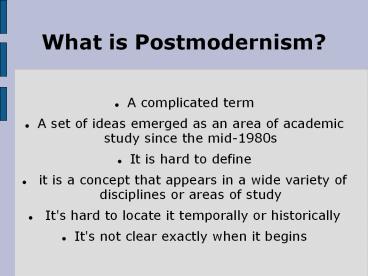What is Postmodernism? - PowerPoint PPT Presentation
Title:
What is Postmodernism?
Description:
What is Postmodernism? A complicated term A set of ideas emerged as an area of academic study since the mid-1980s It is hard to define it is a concept that appears in ... – PowerPoint PPT presentation
Number of Views:221
Avg rating:3.0/5.0
Title: What is Postmodernism?
1
What is Postmodernism?
- A complicated term
- A set of ideas emerged as an area of academic
study since the mid-1980s - It is hard to define
- it is a concept that appears in a wide variety
of disciplines or areas of study - It's hard to locate it temporally or
historically - It's not clear exactly when it begins
2
Philosophy of Postmodernism
- All truth is limited, approximate, and is
constantly evolving (Nietzsche, Kuhn, Popper). - No theory can ever be proved true - we can only
show that a theory is false (Popper). - No theory can ever explain all things
consistently (Godel's incompleteness theorem). - There is always a separation between our mind
ideas of things and the thing in itself (Kant). - Physical reality is not deterministic
(Copenhagen interpretation of quantum physics,
Bohr). - Science concepts are mental constructs (logical
positivism, Mach, Carnap). - Metaphysics is empty of content.
- Thus absolute and certain truth that explains
all things is unobtainable.
3
Human Condition in Postmodernism
- Postmodernism may be considered a reaction
against that confidence in reason. - There is no God up there we are alone here.
- The concept of finite is a barrier that can never
be leapt.. - There is nothing above us
- There is no transcendent reality.
- There is no objective truthavailable to us.
- We are finite, limited people in a particular
space and time. - There is no way to have access to objective truth
- There is no possibility to really know anything.
- The brain may beconsidered only an organism that
can be known through anexperiment in a
laboratory. - Human beings have only got Language.
4
Another Postmodernism's definition
- Postmodernism is the belief that
- Most theoretical concepts are defined by their
role in the conjectured theoretical network. (A
subset are 'operationally' defined by a fairly
direct tie to observations.)? - The theoretical network is incomplete.
- It follows that theoretical concepts are 'open',
or what logicians call 'partially interpreted'.
Research continues precisely because they are
open the research task is to 'close' them,
although never completely.
5
Features of Postmodernism
Socioeconomic part
- Multinational capital
- Reproduction
- Information / Service
Poetics
- Decentred subject
- Caricature
- Labyrinth
- Intertextuality
6
Postmodernism from a literary perspective
- An emphasis on impressionism and subjectivity in
writing (and in visual arts as well) an emphasis
on HOW seeing (or reading or perception itself)
takes place, rather than on WHAT is perceived. An
example of this would be stream-of-consciousness
writing. - A movement away from the apparent objectivity
provided by omniscient third-person narrators,
fixed narrative points of view, and clear-cut
moral positions. Faulkner's multiply-narrated
stories are an example of this aspect of
modernism. - A blurring of distinctions between genres, so
that poetry seems more documentary (as in T.S.
Eliot or ee cummings) and prose seems more poetic
(as in Woolf or Joyce). - An emphasis on fragmented forms, discontinuous
narratives, and random-seeming collages of
different materials. - A tendency toward reflexivity, or
self-consciousness, about the production of the
work of art, so that each piece calls attention
to its own status as a production, as something
constructed and consumed in particular ways. - A rejection of elaborate formal aesthetics in
favor of minimalist designs and a rejection, in
large part, of formal aesthetic theories, in
favor of spontaneity and discovery in creation. - A rejection of the distinction between "high"
and "low" or popular culture, both in choice of
materials used to produce art and in methods of
displaying, distributing, and consuming art.
7
Language
- We produce ourselves in language
- We use different types of language according to
the different situations we have to face. - Language is the only way to characterize a
character in a text.
8
Texts and Intertestuality
- There is nothing outside the text
- All texts are the product of Intertestuality
9
Example of Postmodern Texts
- Nice Work
- by David Lodge
- Possession
- by A.S. Byatt























![❤[PDF]⚡ Woke: An Evangelical Guide to Postmodernism, Liberalism, Critical Race Theory, PowerPoint PPT Presentation](https://s3.amazonaws.com/images.powershow.com/10071885.th0.jpg?_=202407041212)







